INDEX
- Europe from 8th – 11th centuries
- Spanish Christians Kingdoms
- Situation of the North at the beginning of 8th century
- Kingdom of Asturias
- Pyrenees
- Kingdom of Navarra
- Aragon counties
- Catalan Counties
- Castilla: From the county to the Crown.
- Culture and Art (8th to 10th)
- Taifas Kingdoms (1031- 1492)
- First Taifas Kingdom (1031-1085)
- Almoravid Empire (1085-1146
- Almohades (1146 -1212)
- Nasrid Kingdom of Granada (1238-1492)
- Economy in Christian Kingdoms
- Europe from 11th -15th centuries
- The renaissance of the cities
- Urban Society
- Economy: Development of trade
- Political Institutions
- The Late Middle Age
- Crisis of the 14th
- Black Death
- The end of Middle Ages
- Crisis of the 14th
-
Europe from 8th-11th centuries
Europe during Early High Middle Ages lived the times of Feudalism. It was a time of conquests/invasions (Vikings in Northern Europe, Saracens in the Southeast, Magyars in Central Europe). The religion, Christianity mainly ruled life in these centuries. As a result of this new lifestyle, physiognomy turned into a more warlike society, defending territories from foreign threats and their faith from Pagans and Muslims, therefore, Christians became stronger and developed a complex system society very linked to power (Kings and Church). Within this context, European society spread their customs and lives. Keep in mind feudalism, keep in mind Carolingian empire, also al-Andalus because, simultaneously, Europe is living under different cultures and threats.
-
Spanish Christians Kingdoms
The 8th century on the Iberian Peninsula. Tariq had entered throughout Southern Spain (Gibraltar/Tarifa). In a few years, the settled across the Iberian peninsula with no resistance up to Northern territories (Vascones, Astures, Cantabrian). Muslim´s pressure stopped at Covadonga, after the Battle of Covadonga in 722. This is commonly date used to consider the beginning of the “Reconquista” (Reconquest). From this date started what it is called Christian Kingdoms. At the beginning, Astur´s King, Pelagius, led the rebellion against Muslims. After Covadonga, Christians from different parts of Iberian Peninsula extend their domains over North and Center of Spain. Different counties, then kingdoms became bigger and stronger with every alliance (Castilla, Astur-Leonés, Aragón, Navarra, Portugal).
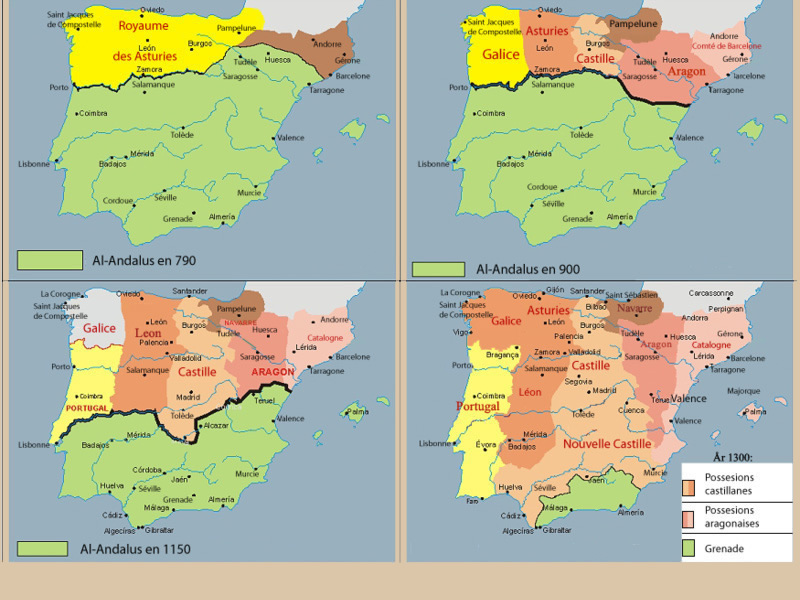
These five kingdoms ruled Christian territory during Middle Ages until the unification of Castilla and Aragón in the 15th century.
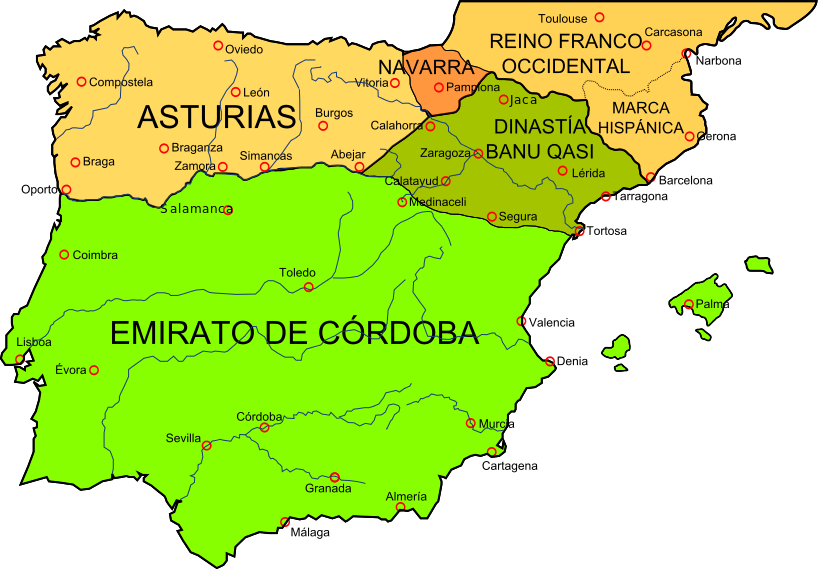
2.1 Situation of the north of the Iberian Peninsula at the beginning of the 8th century.
It was a scarcely Romanised region and it was almost independent during the Visigothic rule. People lived in hamlets.Their economy was based on cattle raising and fishing.There was neither trade nor currency.The inhabitants of the northernmost regions sacked the richest lands. Muslims did not have any interest in conquering these lands due to their poverty and hostility.
2.2 Kingdom of Asturias
Visigothic nobles took refuge in Asturias after the Muslim invasion. They reached some peace agreements with the local population. The Visigoth Pelagius was accepted by the Asturians as his chieftain.

He was captured by the Muslims and taken to Cordova so that Asturians swore allegiance to the emir.Pelagius fled from Cordova. When he arrived in Asturias he was crowned as the kings of Asturians and Visigoths.The Cordovan emir attacked the new Asturian kingdom:
Muslims were defeated in the battle of Covadonga (722). Christians took this battle as the mythical beginning of the Reconquista (Reconquest). Thus the Asturian Kingdom became in the first Christian Kingdom.Therefore, the Kingdom of Asturias fixed its first capital at Cangas de Onís and it was moved later to Oviedo.
The situation of the peninsular Christian kingdoms around the year 1000. There were continuous fights between Christians:
- The Caliph acted as the mediator between them.These kings were vassals of the Caliph and paid tributes to him.
- The population grew due to the arrival of many Mozarabs from Al-Andalus. A new independent territory was created, the County of Castilla:

2.3 Pyrenees. From the counties to the kingdoms.
In this region there were few Muslim settlements, only located in major cities, such as Huesca or Pamplona:
- These walis were rebelled to the Cordovan emir due to the distance.The Banu Qasi family (around Tudela) staged many revolts against the Muslim rulers.
- Charlemagne meant to control this region to be protected from Muslims:
He helped the rebel walis against the emir, like in Zaragoza in 778.He fortified the Pyrenees and appointed counts in the most dangerous areas.This zone was known as the Hispanic March.Carolingians controlled Catalonia much better, but it was more difficult for Franks to govern the future regions of Navarre and Aragon.
After Charlemagne’s death (814), the Frankish power declined in the Hispanic March. Major local families held the government. There was a gradual independence of these regions.
– The Kingdom of Pamplona (Navarra)
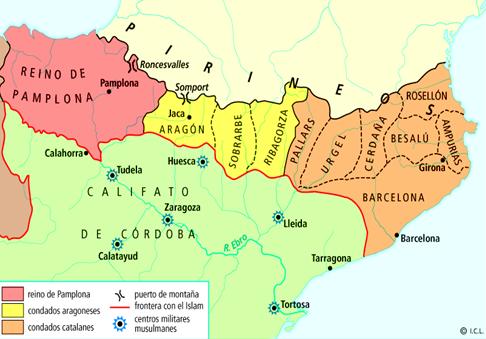

Íñigo Íñiguez Arista was the first leader of Pamplona in the first half of 9th century. After getting rid of the Carolingians, It reached its peak in the early 11th century under Sancho III ‘el Mayor’ (992-1035) He was Adb-al-Rahman III´s cousin.
Navarra turned to France during the 13th. A French dinasty occupied the throne of Navarra, briinging a series of fiefdoms located in France. So, Navarra was linked to the Foix House (a French dinasty). Until 16th century was not unify to Castilla and Aragon.
– Aragon County.
Aznar Galíndez became the first independent count of Aragon (820). In the 11th century became in a Kingdom, unificating the the Catalan counties and Aragonese counties.
During the 13th century with the conquest of Valencia and Balearic, Aragon became in Crown.

– Catalan Counties.

Catalan counties c. 1000
Wilfredo el Velloso (the Hairy) became the first independent count of Barcelona and unified many Catalan counties. He established the first Catalan dynasty (878).
In 1137 Aragon and Catalan counties were unified.
2.4. Castilla. From the county to the Crown.
The origin of Castilla is irremediably linked to Astur-Leonés Kingdom. It had been a county within the Kingdom of León to be protected from Muslim raids.Counts were almost independent of the Leonese kings.They could thus take the decisions in those borderlands. Castilians accepted better the count’s authority than the king’s. Fernán González became the first independent Castilian count (c. 950) during Ramiro II of León’s reign.
The Kingdom of León declined after the 10th century, and Castilla counties increased their power. Castilian territory was in frontier with the Muslims, so they had a lot of castles to defend the Christian territory from attacks. Castile counties became united under the count Fernán González (930-970). From 951 he governed Castile independently from León.

Castile became the most powerful Christian kingdom, from the 11th. century. Alfonso VI conquered Toledo in 1085.
- In 1139 (12th century) Portugal became an independent kingdom.
- In 1230 Fernando III unified León and Castilla founded the Crown of Castilla.
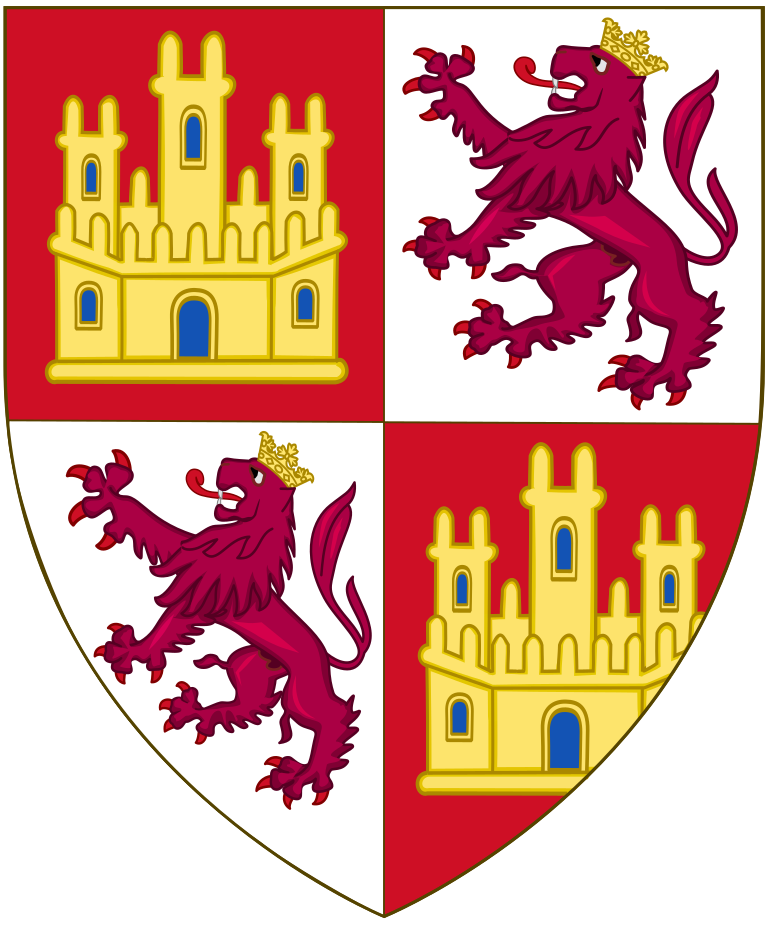
2.5. Culture and Art from 8th to 10th. centuries.
The activities of Christian settlements was focused in the monasteries, including those of Ripoll and Sahagún (Catalonia) In the monasteries monks developed copied and translation of books and chronicles were written reflecting the main events of each kingdom.
Two styles were developed in art: Asturian pre-Romanesque and Mozarabic.

Santa María del Naranco (Oviedo)
Buttresses to support the barrel vault and stilted round arches. Its decoration includes columns with rope moulding and the use of medallions.

San Miguel de Lillo (Asturias)
San Miguel de la Escalada (León) is the most important and representative building of Mozarabic style in the Iberian Peninsula. The Mozarabic style was developed in the 10th century by Mozarabs who reached the Christina territory in the 9thcentury, fleeing repression in the Muslim lands. It uses horseshoe arches reflected the Andalusian influence.

Link to Google maps: Sta. María del Naranco: https://goo.gl/maps/oJ5QRrhjgJ32Link to Google maps: San Miguel de la Escalada: https://goo.gl/maps/j6NvRo7JZ222
3.Taifas Kingdoms (1031 – 1492)
After the collapse of the caliphate of Cordoba, the Taifa Kingdoms were proclaimed (1031).
3.1 First Taifas Kingdoms (1031 -1085)
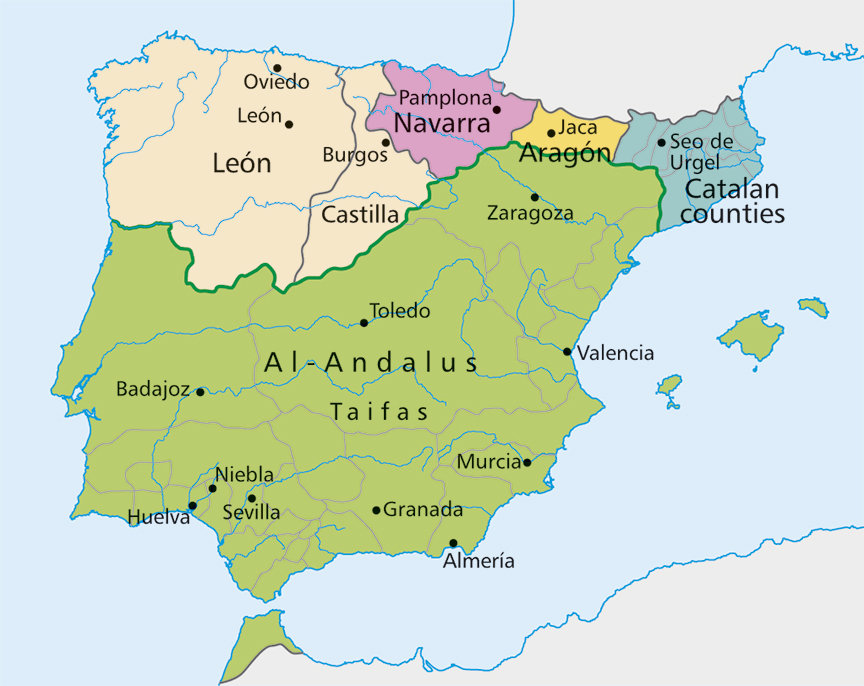
– They were little states controlled by petty kings.
– Only the kingdoms of Zaragoza, Toledo, Badajoz, and Seville were large kingdoms.
– These kingdoms varied basing on the ethnic origin of their rulers:
- Arab Taifa Kingdoms: Badajoz. Toledo. Zaragoza. Lérida. Albarracín. Alpuente. Murcia. Cordoba. Seville. Arcos. Niebla. Huelva. Saltés. Mértola. Santa María del Algarve. Silves.
- Berber Taifa Kingdoms: Granada. Málaga. Ronda. Algeciras. Morón. Carmona.
- Slavic Taifa Kingdoms: Almería. Denia. Valencia. Tortosa.
Theses kingdoms were very weak and became in vassals of Castile during their evolution. Only the Nasrid Kingdom of Granada resisted to Christian pressure until 1492.

3.2 Almoravid Empire (1086-1145)

Almoravides emerged in the north of Africa in the mid 11th century.
They meant to restore the Islamic purity and rigour.They controlled over the Maghreb in 1053 and fixed their capital in Marrakech. Almoravides were really strict on religious affairs. They persecuted everything they considered dangerous for Islam: Literature, Philosophy and Art.
People in Al-Andalus did not support Almoravid due to their fanaticism. They were expelled from Al-Andalus in 1145. Second Taifa Kingdoms were proclaimed after their expulsion.
3.3 Almohad Empire (1146-1212)
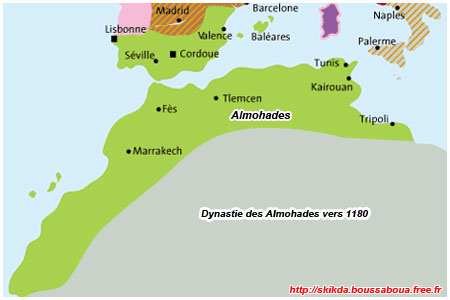
– IBERIAN PENINSULA IN 1212
Almohades were another Islamic movement that was born in the north of Africa in the early 12th century. They conquered the Almoravid Empire. Almohads crossed the strait of Gibraltar in 1146 and conquered many major cities. They finally subjugated all Al-Andalus.
Their new capital in Al-Andalus was fixed in Seville. The Almohad emir Abu Yusuf defeated the Christian kings of Navarre, Castilla, and Leon in the battle of Alarcos (1195), which meant that Muslims re-conquered the basin of the river Guadiana. http://www.artehistoria.com/v2/contextos/8754.htm
There was a definitive fight between the Almohad emir and the Christian kings in the battle of Las Navas de Tolosa (1212) http://www.artehistoria.com/v2/contextos/8755.htm. A co-alliance among Navarra, Aragon, and Castilla. This Christian victory opened the roads towards the South, to the Guadalquivir valleys, which allows the conquered of many important cities in the south, during the 13th., Jaen, Cordoba, and Sevilla, by Fernando III, and Murcia, by Alfonso X.
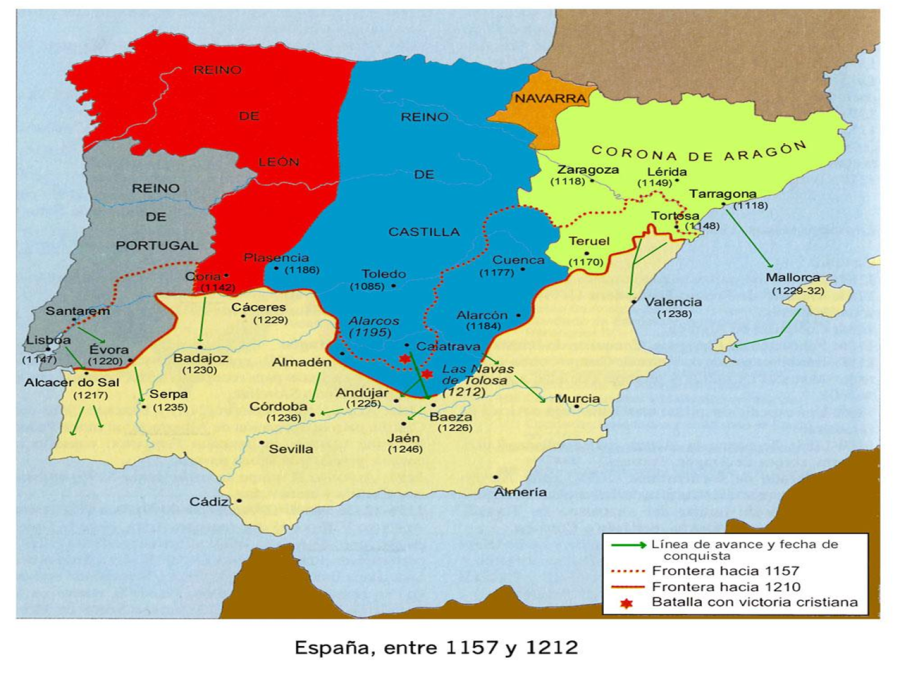
Reconquista´s Video
3.4 Nasrid Kingdom of Granada (1238-1492)
Muhammad ibn-Nasr, wali of Arjona, created the Kingdom of Granada taking profit of the Muslim internal situation. He conquered Granada, Almería, and Málaga. He had to pay tributes to the Castilian kings so that they did not conquer his kingdom. He even helped Ferdinand III conquer Seville (1248) and he became a vassal of Castile.
In the Nasrid Kingdom, there were many internal struggles among noble families. The main kings were Yusuf I (1333-1354) and Muhammed V (1354-1359, 1362-1391). They commanded the construction of the Alhambra. The 15th century was quite unstable in the kingdom.
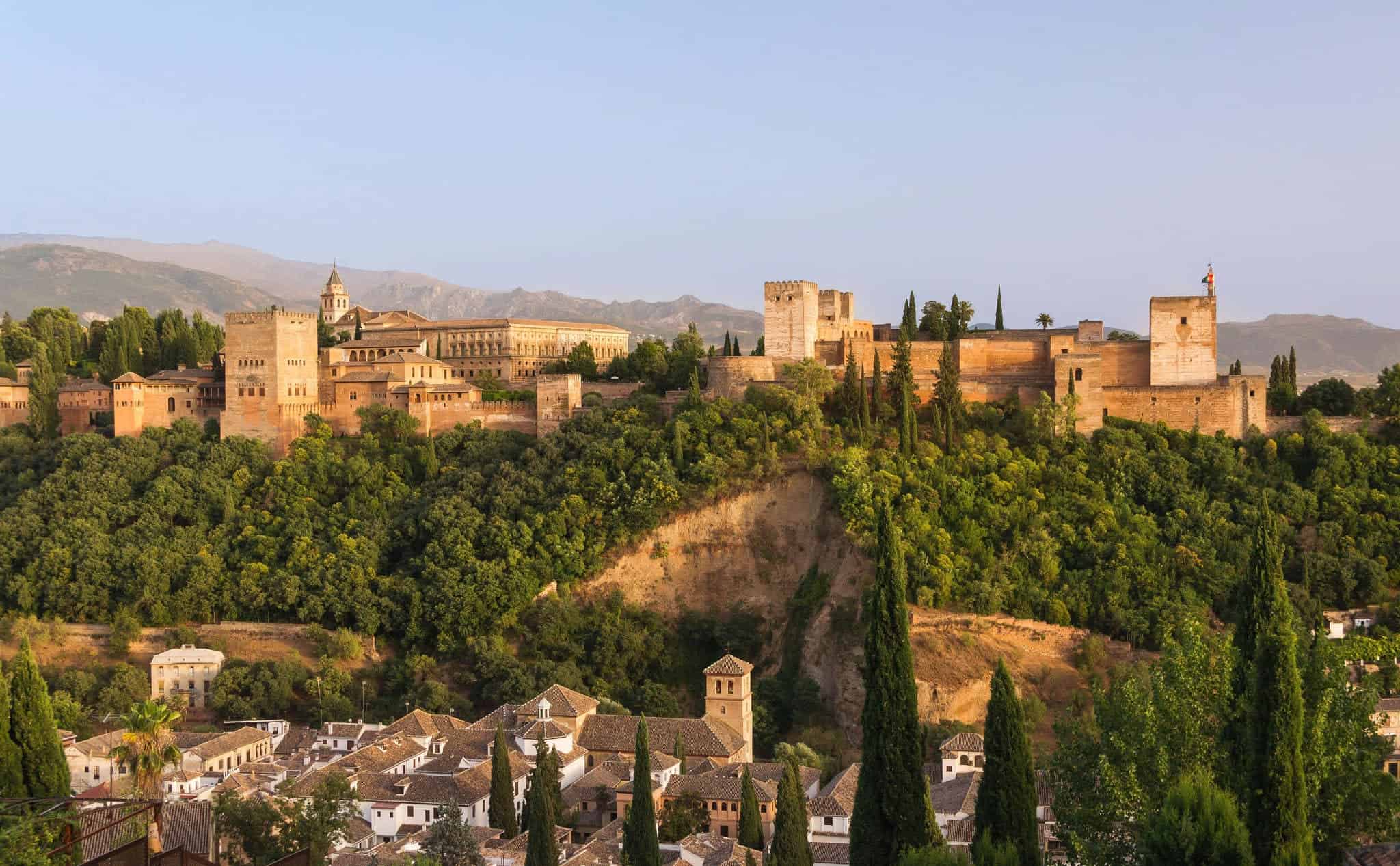
The Alhambra from San Nicolás viewpoint
King Boabdil (Muhammad XII) was in the war against his uncle Zagal (Muhammad XIII) in order to control over the kingdom.Boabdil wanted to gain prestige by invading Castile.
The Catholic Monarchs, Isabel, and Fernando, declared the war on Boabdil in 1485.
The Christian troops conquered Granada, finally on 2 January 1492 after the surrender of Boabdil. This last Muslim kingdom was incorporated to Castilla.

La rendición de Granada (Francisco Pradilla). Picture of the 19th century that depicts the moment in which Boabdil give the key to the city to Catholic Monarchs
La rendición de Granada (RTVE)
-
Economy in Christian Kingdoms
Repopulation allowed increasing the work in countryside. Retook abandoned villages and exploitations, and recovered as farming lands. Economy basicly was composed by livestock and farming until the 14th and 15th. Social and economic advances rose and made Castilla and Aragon grew. The economy in Aragon was fostered and increased because of the trade in the Mediterranean Sea. Trade contacts with Italian and Arabian. This advances favoured the emergence of Exchanges (lonjas). Valencia and Palma Llotjas, or Exchanges, like the Silk Exchange (pg. 75 in the book)
In Castilla, Alfonso X fostered la MESTA (1273) was a very important association of nobles and rich landowners that support the shepherd in Castilla, allowing the movements of sheep from the North to the south occupying farming lands to feed the cattle. Seasonal migration of large flocks of Merino sheep. They left the spring to spend the summer in the meadows of northern Spain, and came to the south in winter folowing “cañadas”. TRASHUMANCIA: Using cañadas (traditional routes for livestock, broad ways) from North to South were spread in these years.
Fairs where the wool and farming were sold allowed the increase and developed of trade. Economy improved. People move from the countryside to the cities. Appearance of new cities (burgs) where urban people, craftsmen and merchant people lived, and developed their economic activities. Bourgeoise from 14th on.
Fairs like Medina del Campo or Burgos became very popular. Once a year was celebrated the fairs where they exchanged goods. The merina sheep wool exportation to Flanders. Ports in the North of the Iberian Peninsula developed this trade (Cantabria and Pais Vasco)
According to these improvements, the society changed. Appeared the Guilds (medieval associations, as of merchants or artisans, organized to maintain standards and to protect the interests of its members, and that sometimes constituted a local governing body) in order to defend and support the union of merchants and workers.
Last two centuries were marked by different events that made difficult to live in Castilla and Aragon. That finished with the new political situation during the 16th. New discoveries that brought to Hispanic Kingdoms new products, new minerals, such as Gold and provoked the grown and wealthy of the Crowns, reflected in many cases in improvements in the way of life of peasants.
But hunger and diseases (like Black Death) provoked a huge social and economic crisis. The 14th century was terrible in this way. Bad crops and Bubonic Plague determined this century.
– Social conflicts: Social conflicts due to the crisis situation. In the countryside crisis of the feudal system. Clashes between different factions of nobles were typical during this era. Against lords, there were some rebellions and uprisings. Civil wars in Castilla. Some revolts in Aragon (Biga y Busca in 15th c.). In the cities. Struggles between the oligarchy and craftsmen. (Barcelona)
– Religious conflicts: Jewish quarters were assaulted. Persecution and Prosecution of Jewish in Castilla (Sevilla, Cordoba, Toledo) and in Aragón (Valencia, Mallorca and Barcelona). From 15th on, Tribunal of the Holy Office of the Inquisition (1478).
– MILITARY ORDERS.
In Hispanic Kingdoms, in order to defend the reconquered territory a new institution was born related to two main pillars: Faith and War. MILTARY ORDERS. It was a combination on religious and chivalry institution (Warriors monks). The function was to defend and protect the serfs during repopulation. The Kings gave to the noblemen latifundios, (big portions of land) to set in there and developed economy.
So Military orders settle in different places across La Mancha, Extremadura, Baleares, Valencia, Murcia and Andalucia. Very important to repopulate Duero, Ebro, Tajo and Guadiana Valleys.
The four Military Orders: Alcántara, Calatrava, Santiago, Montesa

The most powerful in Castilla were Calatrava, Santiago and Alcántara. In Aragon, the Order of Montesa.
5. Medieval Europe: 11th to 15th centuries.
5.1 The High Middle Ages.
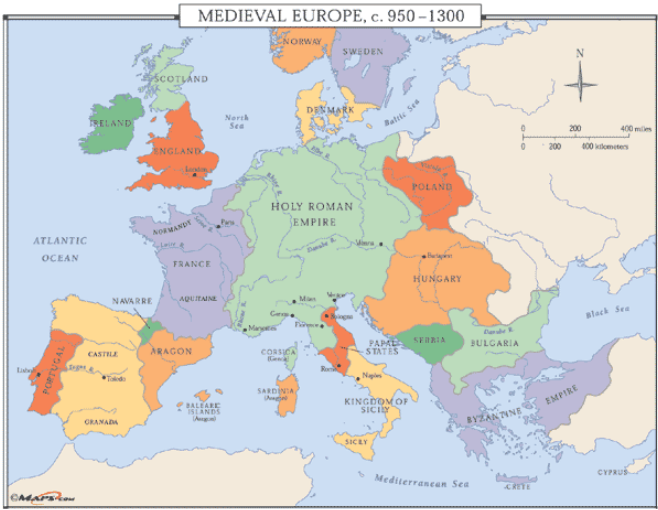 Christian Europe was a mosaic of states at the end of the 11th century:
Christian Europe was a mosaic of states at the end of the 11th century:
France and the Holy Roman Empire were the main states at the centre. Both of them had many feudal territories out of the royal or imperial rule. o Normans (former Vikings) occupied some lands in France, all England, and Sicily, apart from the areas they controlled in the north. They did not attack any other land after the 11th century.Muslims controlled some parts of the Iberian Peninsula and disputed against the Byzantine Empire.Slavs established powerful states in Eastern Europe, such as the Principality of Kiev.
5.2 Urban society
Renaissance of the cities:
There was a renaissance of the cities in the 12th century thanks to the evolution of feudal Europe, that allowed population grew. Migrations from the countryside to cities. The appearance of merchants and craftsmen and in order to organize them, the guilds (any of various medieval associations, as of merchants or artisans, organized to maintain standards and to protect the interests of its members, and that sometimes constituted a local governing body).

From the 11th century on, technical innovation applied to agriculture and the growth in the amount of cultivated land meant that agricultural productivity could increase. Two processes occurred that brought a gradual recovery of the urban world, loss during Dark Age:
-An increase in the rural population. Many peasants migrated to the cities, due to the shortage and high cost and demographic pressure.
– Agricultural surpluses were sold in cities. Provoked the appearance of a new collective: GUILDS in the 12th century.
- Many cities were founded within the land of secular or ecclesiastic manor (fief), organised around fortresses or churches. These cities had special rights, gaining independence from the control of the manor.
- To protect the city walls and ramparts were built.
- The most important cities belonged to the Crown.
- Cities had a thriving artistic life and the bourgeoisie contributed to their splendour by contributing money to build cathedrals and large buildings.
The feudal structure of society was maintained. Nobility and clergy kept their privileges and Lords and vassals kept their dependent relationships.
The population grew according to the increasing of crops. The great merchants and bankers were the richest people in the cities and the member of local government. Urban inhabitants enjoyed greater freedom than peasants. And they worked in many different activities, such as trade, crafts, administration, etc. Traders and craftsmen joined in GUILDS (associations rigidly hierarchical regulated by strict rules regarding working conditions, quality and prices).
Guilds: Bakers, blacksmiths, crafts, merchants, tanners, clockmakers, etc.

Workers, peasants, and beggars, completed the urban society.
5.3. Economy: Development of the trade
After the fall of the Roman Empire, long-distance trade had almost disappeared in Western Europe due to insecurity, general poverty and bad roads and paths that made difficult the trade.
Since 12th century, trade revitalization occurs in local and long distance trade. The reasons were:
- Safer trade routes. Knights (military troops) made safer these routes.
- Four wheels wagon and improvements in navigation (astrolabe, compass).
- The increase of coin circulation, what it means more money for the people.The appearance of bankers and lenders. Bills of exchange (a document ordering a payment).
- Fairs organised by the cities, where the traders could meet under king´s protection, and sell the products safely.
- North Sea and Baltic routes that trade wood, salt and iron, controlled by an institution: Hanseatic League.
- East route. Emerged the figure of Marco Polo who reached China and described his journeys in “Book of the Marvels of the World” Development of Atlantic and Mediterranean trade routes. Silk Routes with eastern (Byzantines and Muslims). Exchange of spices and perfumes, etc.
In these years, from 11th c., Vikings raided even Iberian Peninsula, across Mediterranean, arriving up to Sevilla and Mediterranean islands, after that.
5.4. Political Institutions
Papacy (Papal Estates)The highest moral authority of Catholicism and also aspired to hold political superiority above that of kings and emperors. His aim was to establish a theocracy (a system of government in which religious power is imposed over civil power). Holy Roman Empire were the most important institutions. Holy Roman Empire was founded in the eastern in 962. This institution sought to be the defender of Christianity and the Pope, so its emperors considered themselves superior to all other powers. Emperors were elected by an Assembly of German nobles and bishops known as DIET.
Monarchy, the other important political institution during Middle Ages, that gained power and tried to regain the authority from the feudal nobility, granting the cities FUEROS (regional code of laws and privileges), that gave them, independence from the nobles and taxes to the king what increased the authority meanwhile feudal lords started to lose their power and relevance in economic and political way.
6. The Late Middle Age
6.1 Crisis of the 14th century.
General crisis based on:
- Demographic crisis due to the Black Death, hunger and wars.
- Religious crisis. Catholicism that led to the Western Schism with two Popes (Rome and Avignon)
- Political crisis.The Hundred Years´ War. France and England were the main belligerent countries , but were involved a lot of European kingdoms, in one of the most famous events of Middle Ages. In this war, emerged the figure of Jeanne d´Arc.
- Social crisis in the countryside, where peasants sought freedom from their serfdom by attacking the nobles. In the cities, the poorest people revolted against the local government.
Learn more about the Black Death. Bubonic Plague.
6.2. The end of the Middle Ages.
The 15th century was a recovery century in which monarchies strengthened their power, thanks to the rise of the cities and the urban bourgeoisie. An example of that was that the most of the European population lived in cities in kingdoms such as Castile, England or France.
The population growth, the increasing of needs, fostered to the kingdoms to launch geographical expeditions and new discoveries in America and Asia, in 15th and 16th centuries. Expeditions in search of metals and food.
Common dates that marked the end of Middle Age.
1453. The fall of Constantinople
1492. Discovery of America by Christopher Columbus.


2 Comments